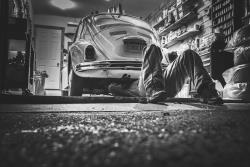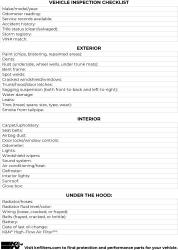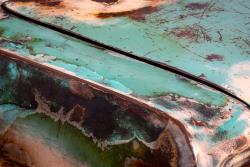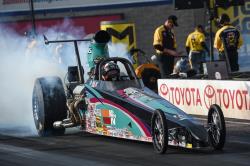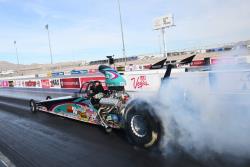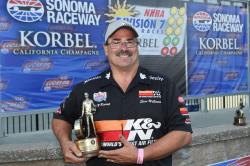| There are few events more thrilling in the automotive industry than SEMA, one of the most elite and exclusive automotive trade events in the world. For a few days each fall, the brightest, most innovative minds in the industry—and all the most exciting new products—converge at the Las Vegas Convention Center for product demonstrations, unique events, and opportunities to network. The 2017 event saw more than 70,000 attendees, with over 3,000 newly introduced products, and the 2018 event has proven itself to be equally exhilarating. 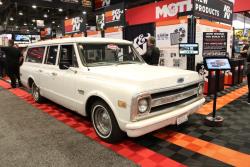
This 1969 Chevrolet suburban will be fully restored for SEMA 2019—and you can help choose the build! | K&N has been featuring several new products at this year’s show, including the ECI system (electronic carburetor injection), and the soon-to-be-available Boost Control Module and Throttle Control Module. In addition, the K&N booth included a custom-built Yamaha RD400, a 1969 Chevrolet suburban (which will be fully rebuilt for the 2019 show!), and a 2019 Chevrolet Silverado with a custom prototype intake system.NEW K&N PRODUCTS FEATURED AT THE SHOWECIThe K&N ECI is a bolt-on system which adds a supplemental fuel source to improve engine performance. Comprised of a spacer plate with a fuel block and injector, an electronic control unit (ECU), and wide-band oxygen sensor, installation can typically be completed in a matter of hours. Better yet—after setting five simple parameters, the system can tune itself. After installing your new ECI system, hiccups on cold starts can be a relic of the past. 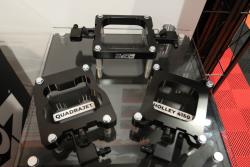
The ECI system is available for Holley 4150s, Holley Dominators, and Quadrajet-style carburetors | THROTTLE CONTROL MODULEThe K&N Throttle Control Module processes input data from the gas pedal and bypasses the factory signal to the vehicle’s ECU, sending a modified signal directly to the throttle body—creating an increase in throttle responsiveness that will make your car feel like a whole new machine. BOOST CONTROL MODULEK&N’s new Boost Control Module works within factory parameters to increase boost—improving throttle response, and offering a power increase of up to 47 horsepower. The system can typically be installed in less than 30 minutes (no software required), and is adjustable on-the-go—helping you fine-tune your boost level to your preferences and needs. When you need more power, simply adjust the dial to give your acceleration a bit of extra muscle. NEW BLACK OIL OPTIONK&N also introduced a new black oil option as a companion to the traditional red oil—allowing enthusiasts of blacked-out engine bays to customize their cotton air filter’s aesthetic to their preferences. VEHICLES FEATURED AT K&N’S SEMA BOOTH 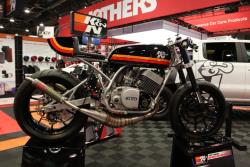
The Yamaha RD400 built by Nick O’Kane and his son Max | YAMAHA RD400 RETRO RACERNick O’Kane, a National Account Manager at K&N, introduced a custom Yamaha RD400 at the K&N booth at SEMA this year—a collaborative project with his son, Max, for his senior project at Riverside STEM Academy in Riverside, California. The Yamaha RD400 air-cooled twin was launched in 1976 as a slightly more refined version of the Yamaha RD350. The bike was an instant hit, and highly sought after by many riders. This minimalistic, retro racer RD400 came to life after O’Kane purchased the bike (in boxes) from a garage sale at Jeff Palhegyi Designs. JPD Designs had completed the frame modifications to convert the RD400 from twin-shock to mono-shock, which included fabrication of custom swingarm and triple trees to fit the race wheels from Marchesini. The gas tank had also been extended and tail unit designed to match. O’Kane and his son greatly enjoyed finishing the build, and adding their personal style to a solid foundation. Together, they would like to thank JPDesigns for their assistance with the build project. 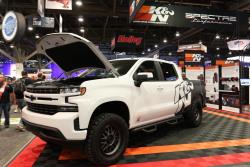
On display was a 2019 Chevrolet Silverado, featuring a prototype K&N intake system | 2019 CHEVROLET SILVERADO PROTOTYPE INTAKEThe research and development department at K&N created a prototype intake system for the 2019 Chevrolet Silverado—so keep your eyes out for a product release in the near future! K&N designs every intake system to provide increases in horsepower, helping you take your new (or new-to-you!) vehicle to its performance potential. PICK YOUR FAVORITE BUILD + ENTER TO WIN AN INTAKEK&N also introduced a build project that will be completed for SEMA 2019—a 1969 Chevrolet suburban—and has left it up to the public to decide from four awesome build choices. You can vote for your favorite option by following this link, and you’ll also be entered to win a free intake (please click on the link for full terms and conditions)! The entry period ends at 11:59 p.m. PST on November 11th, 2018. Be sure to follow K&N’s Facebook page and Instagram to view exciting footage and images from SEMA 2018! 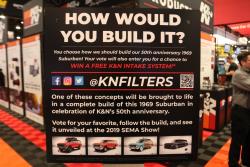
Follow the link in the feature to vote for your favorite build option | |

Vaughn Gittin Jr. drifting the Nürburgring | Drifting is not a sport for the faint of heart, and Vaughn Gittin Jr. is anything but. Since 2004—Formula Drift’s inaugural year—he has been a self-proclaimed “professional fun haver”; the rare combination of a fierce competitor with the heart and passion of a dedicated hobbyist. Always watchful for the next big challenge, Gittin Jr. recently completed a world first—drifting the entire north loop at Nürburgring.Built in the 1920s in the Eifel mountains of Germany, the Nürburgring north loop (Nordschleife) is 12.9 miles of demanding turns with over 1,000 feet of elevation change. The former location for the German Grand Prix, the loop has earned the moniker “The Green Hell”. Gittin Jr. became the first driver to drift the entire course—demonstrating both his driving prowess and the power and agility of his Mustang RTR. 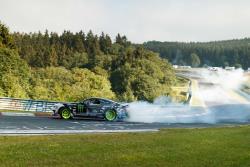
The Mustang RTR reached speeds of 150-mph on the track | Gittin Jr. began competing in Formula Drift in his personal Nissan S13, but quickly captured the attention of Ford Racing, who began a partnership with him in 2009. Ford and Gittin Jr. collaboratively launched the Mustang RTR in 2010. Today, Vaughn races in the Monster Energy Nitto Tire Ford Racing Mustang, which features a 900-horsepower, 9000-rpm engine built by Ford Performance and Roush Yates Engines. 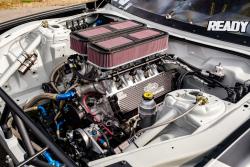
The Mustang RTR features a 100-8578 filter assembly | He has an impressive list of wins—including three World Drift Series Championships (2011, 2012, and 2013), and the title of the only American to win two D1 Grand Prix events. He was honored as the Formula Drift Ace Driver of the Decade in 2013, which recognized his participation in all ten seasons of the series and the most tandem victories of any Formula Drift driver. He also owns RTR Motorsports (for which he races), based in Baltimore, Maryland.Gittin Jr.’s Mustang RTR features a custom K&N® performance filter—which features the same technology as K&N®’s original High-Flow Air Filters, trusted for their ability to provide exceptional engine protection. You can search for one to fit your vehicle here. “I’ve been working with K&N on an official level for fifteen years now,” Gittin Jr. commented. “But prior to that, I ran K&N [products] on my first car that I used to race in industrial parks and parking lots. That started my love for K&N. It’s an honor, fifteen years later, to still be working with them. No matter what I’m doing—whether it is Formula Drift, Ultra4, or just general fun-having—and no matter where in the world I am, K&N Filters are ready to party with me and are my weapons of choice!" You can see Vaughn Gittin Jr. compete in Round 8 of the Formula Drift Pro Series at Irwindale Speedway in Irwindale, California on October 12-13. |
| In the early 1960s, two motorcycle racers—Ken Johnson and Norm McDonald—developed a ground-breaking new idea for an air filter that could perform under the demands of an off-road environment. After experimenting with many different types of filter media, they discovered that an oiled cotton design allowed the filter to not only capture dirt and contaminants very efficiently, but also allowed it to be washed and reused. Just like that, the original High-Flow Air Filter™ was born. To this day, K&N continues to be an industry leader in filtration technology—and engineers each air filter for efficiency, capacity, durability, and airflow. Maintaining the proper air-to-fuel ratioMaintaining the proper air-to-fuel ratio (AFR) is critical for engine performance, and relates to the amount of air versus the amount of fuel used by an engine for combustion. A correct, stoichiometrically balanced AFR produces combustion with perfect efficiency, excluding other factors. For gasoline engines, the theoretically perfect chemical ratio is 14.7:1—14.7 parts air to one part fuel. In effect, this means that an engine requires almost fifteen times more air than fuel for efficient combustion—which emphasizes the importance of providing a high volume of air through an air filter. How do engines produce power?An internal combustion engine operates by burning a mixture of fuel and oxygen within the engine’s cylinders. A spark plug ignites the volatile gas, creating an explosion that forces the piston downward—turning the crankshaft. The piston-moving force that’s created during the combustion cycle is what produces horsepower. Why not use a disposable paper air filter? 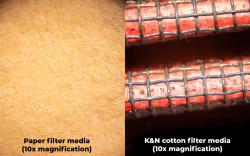
Typical paper filters can be very restrictive to airflow—note the lack of openings in the media | Typical disposable paper air filters function on a size-dependent basis—dirt particles that are larger than the openings in the filter media are blocked, while particles that are smaller than the openings can pass through. Most disposable paper filters create airflow restriction, as the openings in the filter media have to be tiny in order to filter efficiently—which can slow down airflow. Because dust accumulates on the surface of the disposable filter and can block passageways for airflow, the filter’s performance typically decreases consistently throughout its service interval.The four major elements of filtrationK&N designs every K&N filter to balance the four most critical elements of filtration: efficiency, capacity, durability, and airflow. Under normal circumstances, most automotive air filters demonstrate an inverse relationship between airflow and efficiency—the higher the airflow, the less efficient the air filter is at protecting the engine, and vice versa. Many filter companies claim that their filters capture 99% of contaminants (or more), but there’s a trade-off, as most filters designed to block almost all contaminants are likely to also block the majority of airflow—stifling your engine’s oxygen supply. A standard disposable paper filter exhibits a principle called surface loading—dust collects only on the surface of the media, which can provide a high level of contaminant capture/efficiency (the filter is mostly impermeable, which keeps dirt and contaminants from passing through to the engine) but a low level of airflow, reducing engine performance. 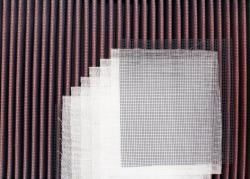
High-Flow Air Filters™ typically feature four or six layers of oiled cotton fabric | In contrast, K&N High-Flow Air Filters™ utilize depth loading, in which multiple layers of pleated cotton fibers provide particle retention on many levels. However, while most typical paper or foam filters would experience an unacceptable reduction in airflow with a dramatic increase in efficiency, High-Flow Air Filters™ are specifically engineered to capture dirt while still allowing a high volume of airflow to pass through. As a result, High-Flow Air Filters™ are able to capture contaminants (efficiency), hold a large volume of dirt (capacity), and still provide an outstandingly high volume of air to the engine (airflow). In addition, High-Flow Air Filters™ are designed to last for the entire lifespan of a vehicle (durability). If I can see light through my air filter, does that mean that dirt is getting through too? 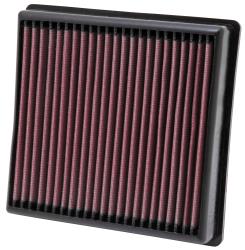
High-Flow Air Filters™ feature a pleated, oiled cotton media | Some consumers have expressed concern that when holding a K&N High-Flow Air Filter™ up to a light source, there are holes/passageways visible in the filter media. If High-Flow Air Filters™ operated solely on a size-dependent basis like a typical disposable air filter, this would be a valid concern—the assumption being that any particles smaller than the passageways would flow through to the engine—but High-Flow Air Filters™ are designed to utilize the principle of diffusion to increase the capture of engine contaminants. Extremely small particles are typically highly affected by forces within the flow of air, including changes in pressure, velocity, or turbulence—and these factors often make their behavior chaotic. While this erratic behavior might sound detrimental to filtration, it can actually be an advantage, as the smallest particles typically do not follow the main flow of air through the passageways in the filter; instead, their chaotic motion causes them to collide with microscopic fibers inside the filter media, where they are then trapped and held by the filter oil. In the media of a typical disposable paper filter, any particles that are smaller than the openings in the media will likely pass right through—but the tacky, sticky nature of K&N filter oil and the multi-layer media design of High-Flow Air Filters™ help capture contaminant particles that are much smaller than the openings/passageways within the filtration media. 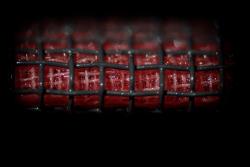
Oiled fibers in the filter media of High-Flow Air Filters™ shown at 10x magnification | Can a K&N oiled air filter cause a mass airflow sensor to fail?An unsubstantiated claim has circulated for many years saying that K&N oiled air filters can cause mass airflow sensors to fail. K&N has thoroughly investigated this claim, and has found no evidence to suggest that K&N filter oil is able to cause MAF sensor damage. In fact, over the past several years, K&N has compiled data regarding MAF sensors sent in by consumers and dealerships, which you can view here: MAF Sensor Test Results. In most cases, the MAF sensors were actually working as they should—which would be a perplexing result, if not for the fact that most dealerships are unable to test MAF sensors. K&N has yet to encounter a dealership with the test equipment necessary to determine whether or not an MAF sensor is functioning properly, which frequently leads to misdiagnosis. For this reason, in almost all cases, the diagnosis of a faulty MAF sensor is merely an educated—or sometimes uneducated—guess. However, in response to consumer concerns, K&N performed extensive testing to determine whether or not filter oil could cause an MAF sensor to fail—going so far as to completely coat an MAF sensor in filter oil—and was not able to create a scenario in which the MAF sensor was damaged by the oil (you can view the procedure and results here: MAF Testing Results and Findings). In K&N’s study, of 437 sensors tested, 298 of them were actually functioning properly (68.19%)—indicating that misdiagnosis of MAF sensors is a frequent issue. Of the sensors that were truly malfunctioning, approximately 33% demonstrated complete electronic failure, with 67% experiencing electrical variance. Of the latter category, over 36% were found to be manufacturer-contaminated with silicone. K&N filter oil was not found to be responsible for any of the sensor malfunctions. DRYFLOW® non-oiled filter media 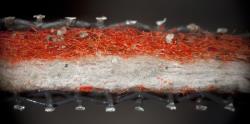
Dryflow® air filter feature lofted media (the red portion of the image) | While the oiled High-Flow Air Filter™ continues to be the most popular filter type among K&N products, K&N also offers non-oiled synthetic Dryflow® air filters. The Dryflow® filter media is composed of lofted synthetic material, which—much like High-Flow Air Filter™ media—provides depth loading properties. However, since Dryflow® filters do not feature the K&N filter oil that is designed to trap and hold particles, the Dryflow® filter media is more restrictive to airflow than High-Flow Air Filter™ media—though it is still designed to strike a desirable balance between airflow and efficiency, provide a high level of contaminant capture, and outperform typical disposable paper air filters in airflow. Because they do not have to be re-oiled, servicing Dryflow® air filters is typically a quick and easy process. K&N filter media types are designed for performanceK&N engineers each filter media type to provide performance for specific applications—for example, heavy diesel and outdoor power High-Flow Air Filters™ are designed with six layers of cotton that feature a particularly fine weave, which can provide an additional level of protection in demanding driving conditions. Synthetic, non-oiled Dryflow® filter media is incorporated into many heavy duty diesel filters, and a large, conical Dryflow® air filter is included with Blackhawk Induction™ intake systems. Many applications will have multiple filter options available, allowing you to select the filter type that fits your needs and preferences. If you have questions regarding filter types, please feel free to contact K&N’s customer service. Join the millions of customers who trust K&N to provide performance and protection products for their vehicles. Visit the application search page to explore air filter options for your specific vehicle. |
| |
